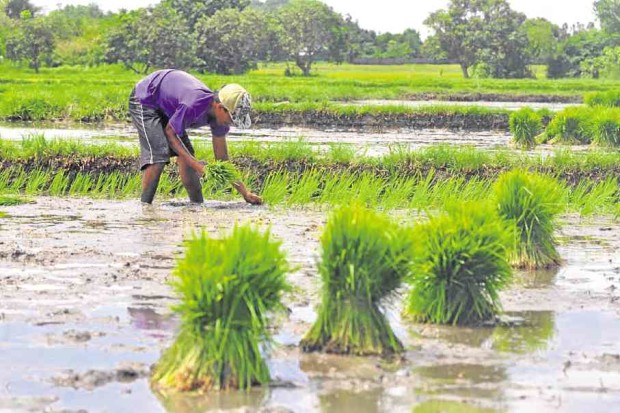DA revives Marcos’ rice program

Rice farmers can expect higher yield as the government taps hybrid seeds in a new agriculture program. —WILLIE LOMIBAO
TALAVERA, Nueva Ecija—A rice farming program popularized by the late strongman Ferdinand Marcos will get an upgrade under the administration of President Duterte.
Marcos’ Masagana 99 will be reintroduced as Masaganang Ani 200 in the next Cabinet meeting, said Agriculture Secretary Emmanuel Piñol here on Wednesday.
Masagana 99 was implemented in 1973, a year after the imposition of martial law.
The program aspired for Philippine rice self-sufficiency by funding an increase in unmilled rice production to 99 cavans per hectare. A cavan is equivalent to 50 kilograms of grains.
Piñol, who joined the town’s harvest festival along with the President, said Masaganang Ani 200 intended to raise palay production to 200 cavans per hectare.
In a speech he gave here on Wednesday, Mr. Duterte described Marcos as ingenious for developing good programs like Masagana 99 which, he said, deteriorated only because of corruption.
Piñol said Masaganang Ani 200 would stabilize food supply as the production of globally traded rice continued
to decrease.
“The truth is we cannot just depend on other countries. We don’t know when the next typhoon will come or when the next El Niño will hit us,” Piñol said, citing the unpredictable impact of climate change.
Article continues after this advertisementLower target
Piñol said he originally aimed for a lower target but he was persuaded by Henry Lim, chair of the grains development firm, SL Agritech Corp., that a target of 200 cavans was attainable by planting hybrid seeds. SL Agritech helped organize the harvest festival.
“We don’t need to expand our area. We just need to improve our technology,” Piñol said.
The festival featured testimonials given by farmers like Edgardo Marcelo, who said he harvested 266 cavans (each weighing 59.3 kg) from his 1.3 hectare farm.
Marcelo said his production earned him P216,000 for a four-month cropping period.
Ricardo Buenaventura, who heads the Nagkakaisang Magsasaka Agricultural Multipurpose Cooperative, put his average yield at 200 cavans per hectare using the hydrid brand, SL-8H.
The cooperative, formed by 16 farmers in 1989, has been helping popularize hybrid rice production. —ARMAND GALANG